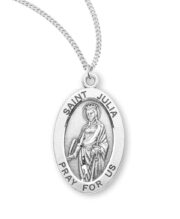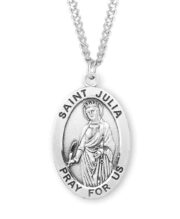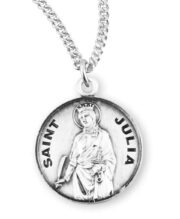Saints
St. Julia Billiart
The Life of St. Julia: A Virgin and Martyr of Corsica
St. Julia is one of the most revered saints in Corsica, the island in the Mediterranean Sea that is part of France. She is also known as Julia of Carthage, Julia of Nonza, or Iulia in Latin. She was a virgin and a martyr who died for her faith in the fifth century, most probably on or after 439 AD. Her feast day is celebrated on May 23 in the Western Church and July 16 in the Eastern Church.
Her Early Life and Captivity
St. Julia was born of noble parents in Carthage, a city in North Africa that was part of the Roman Empire. She was raised as a Christian and devoted herself to prayer, fasting, and reading the Scriptures. She was also known for her cheerfulness, patience, and humility.
When Carthage was attacked by the Vandals, a Germanic tribe that followed the Arian heresy, St. Julia was captured and sold as a slave to a pagan merchant named Eusebius. He admired her courage and virtue and allowed her to practice her faith freely. He also entrusted her with the management of his household and business affairs.
Her Martyrdom and Miracles
One day, Eusebius sailed to Corsica, where he attended a pagan festival in honor of Bacchus, the god of wine. He left St. Julia on his ship, guarded by some sailors. The governor of Corsica, Felix, noticed her beauty and asked Eusebius to sell her to him. Eusebius refused, saying that she was his most valuable possession.
Felix then tried to persuade St. Julia to renounce her faith and worship Bacchus. She refused, saying: “My freedom is to serve Christ, whom I love every day in all the purity of my soul.” Felix became furious and ordered her to be tortured and crucified.
St. Julia endured the torments with joy and courage, saying: “I confess Him who for love for me has endured the torment of the flagellation. For if my Lord was crowned with thorns for me, was nailed to the tree of the Cross, wherefore ought I refuse to let my hair be torn from my head as price for the confession of my faith, that I might be worthy to seize the palm of martyrdom?”
St. Julia died by crucifixion on a hill near Nonza, a town on the northern coast of Corsica. Her body remained intact and incorrupt for several days, emitting a sweet fragrance. A dove was seen hovering over her head, and a bright light shone around her.
Eusebius returned from the festival and was grief-stricken when he saw what had happened to his faithful servant. He buried her body with honor and returned to Syria.
Her Veneration and Relics
St. Julia’s martyrdom was recorded by Victor Vitensis, a bishop of Africa who wrote a history of the persecution of the Christians by the Vandals. He is considered a reliable source of historical information.
St. Julia’s body was later transferred to Brescia, Italy, where it is still venerated today at the Basilica di Santa Giulia (Basilica of St. Julia). Her relics are kept in a silver urn under the main altar.
St. Julia is also honored in Corsica, where she is considered one of the patron saints along with St. Devota. Many churches and chapels are dedicated to her name, and many miracles have been attributed to her intercession.
St. Julia is depicted as a young woman holding a palm branch, a symbol of martyrdom, and a crucifix, a symbol of her love for Christ. She is also sometimes shown with a dove or a light above her head.
St. Julia is an example of faithfulness, courage, and purity for all Christians. She reminds us that nothing can separate us from the love of God, not even death.










